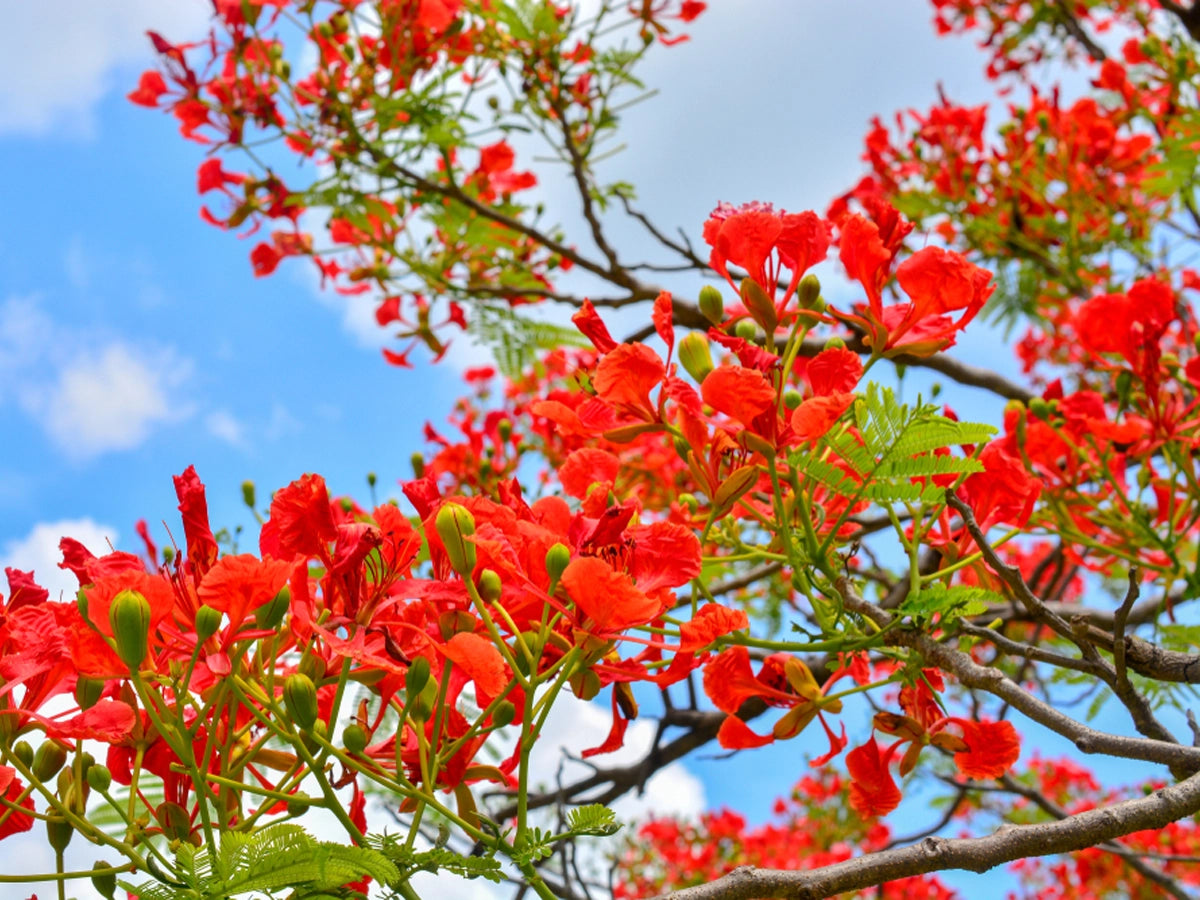How to Grow
Add A Splash of Gorgeousness by Growing Gulmohar in Your Garden
The basic responsibility of ornamental trees and plants is to improve the aesthetic appeal of the area in which they are planted.
We hardly ever come across decorative plants with medicinal qualities! Gulmohar is one such example.
The flaming red color and distinctive pattern of the petals have always been an inspiration to poets, writers, and painters for centuries.
Streets across India have plenty of Gulmohar trees. The tree with the orange-red blossoms that can catch your attention from a distance is the one, in case you still don't know Gulmohar.
So, besides being incredibly beautiful and having some medicinal value, what else does Gulmohar do?
It offers shade and controls soil erosion in arid and semi-arid regions.
Are you excited to learn how to grow a Gulmohar tree in your garden? This blog has all the information you would require. We would cover the following: -
- Interesting facts about Gulmohar
- How to grow Gulmohar in your garden
- How to take care of Gulmohar
- Benefits and uses of Gulmohar tree
So, let’s dive into the sparkling world of Gulmohar.
Interesting Facts about Gulmohar
- Delonix regia or Gulmohar is a species of flowering plant in the bean family Fabaceae that includes legumes, peas, and beans.
- Early in the 19th century, naturalist Wensel Bojer found the Gulmohar tree in its native Madagascar.
- The Gulmohar flowers grow in loose clusters and feature five spoon-shaped petals. The edges are somewhat wrinkled. Color-wise, one is white with flecks of red and yellow, while the other four are scarlet.
- Do you know that the Gulmohar tree is anti-diabetic? The methanol extracts of the leaves of Gulmohar are used to reduce glucose levels in the blood.
- In Kerala, the other name for Gulmohar is “the flower of Calvary." The Saint Thomas Christians in Kerala, believe that Jesus was crucified close to a little Gulmohar tree. It is also believed that Jesus Christ's blood was spilled over the Gulmohar flowers, giving them a bright red hue.
How to grow Gulmohar in your garden
There are two major ways to grow the Gulmohar tree in your garden. The first is from seeds, and the second is from tree cuttings. Read below and know how to grow the Gulmohar tree: -
The Seed Method
Gulmohar can grow naturally from seeds, and you can also use this method to grow a flaming Gulmohar tree in your front or back yard. Read below and learn how to propagate Gulmohar from seeds: -
Getting Gulmohar seeds
After pollination, a fruit or pod develops. When the pod is young, it is green and becomes brown with age. Then it splits in two, and releases hard brown seeds. You have to get these hard, brown seeds to grow a Gulmohar tree.
How are these Gulmohar seeds?
The seeds of the Gulmohar tree are physically dormant and appear tough on the outside. Without shattering this outer covering, the tree's germination is almost certainly impossible.
Gulmohar seed scarification process
- Before sowing, you have to break the seed’s dormancy by weakening the outer layer through the scarification process. Either use a knife or soak the seeds in warm water for twenty-four hours. Keeping the seeds in water ensures a supply of water and oxygen, which aid in germination.
- By lightly nicking or scratching each softening seed with a knife, you can scarify them, which allows the water inside and hastens the germination process. Some experts or experienced gardeners advise peeling the seeds with a brief touch of sandpaper.
Gulmohar seed germination
The germination period for Gulmohar seeds may last anywhere between 12 and 349 days. If you use the method for breaking the dormancy outlined above, germination occurs in 10–12 days; otherwise, it could take up to 349 days.
Planting Gulmohar
- Take a three to six inches deep seed tray
- Fill up the seed tray with a well-draining potting soil
- Plant the Gulmohar seeds carefully
- Remember that each seed should be planted three inches apart and one inch deep
- Pat the potting soil firmly around each seed
Warm location
At this stage, place the tray in a warm and partially shaded area that will aid in seed germination. Maintain wet but not soggy soil. Within four to six days, seeds start to germinate.
Transfer or repotting
Transfer seedlings that are eight inches tall to a 1-gallon container. Select a good, sunny, and spacious location where the tree can take root and beautify your landscape.
Remember that a Gulmohar tree grown from seeds would require anywhere between 5-12 years to mature before it starts to bloom.
The Cutting Method
- Take a cutting about one foot long with a sharp knife from a healthy Gulmohar tree
- All the leaves from the lower portion of the cutting should be removed
- Dip the stem into a rooting hormone that will enhance root development
- Now take a one-gallon container and fill it with a potting mix
- Place the cutting carefully and moisten the soil a bit
- Keep the container away from direct sunlight and opt for a warm yet partially shady area
- It may take several months for this cutting to grow new branches. Till then keep caring for the tree by regularly watering it.
- Once you see new branches or leaves, take the container to a sunny area
How to Take Care of Gulmohar
Sunlight
Gulmohar trees love bright, sunny weather. At least six hours of daily sunlight are essential.
Location
Place the Gulmohar tree in your garden with lots of space for its root to develop. Also, the location should be bright and sunny.
Soil
Clay, loamy, sandy, or gravelly - any type of soil would work for Gulmohar trees as long as it has good drainage quality. The pH range between 4.9 and 10.6 is also acceptable.
Water
You need to water the plant every day in the beginning and keep the soil moist. Overwatering is not a problem, but under-watering can be harmful to the plant, especially when it is young. Water the Gulmohar tree more in the summer and considerably less in the winter. Just ensure the soil dries completely before you water.
Temperature
Gulmohar likes warm, hot, and humid temperatures. However, Gulmohar trees cannot tolerate drought and frost. It means the extremes of both summer and winter won’t be suitable for this tree. Any temperature lower than 7 degrees Celsius or higher than perhaps 40 degrees Celsius will be a problem for Gulmohar.
Fertilizer
After planting, fertilize the Gulmohar tree with a balanced liquid fertilizer for four to six weeks. Follow this two to three times a year for the upcoming three years. In early spring and winter, apply some more fertilizer. And every time you fertilize, remember to water the tree thoroughly.
Pruning
Pruning is important for Gulmohar trees because that will facilitate a sturdy structure and allow them to fight heavy winds. Start pruning the main branches that are half the diameter of the trunk or less than 8 to 12 feet from the ground. The best time for pruning is late March or early April, or as soon as the spring season starts in your area.
Pests & Diseases
- Mostly, Gulmohar is devoid of pests, but some caterpillar species may eat the foliage.
- Spider mites can also be a problem, especially if the tree is not in a wet area. Increase the humidity or move the plant outside if you find spider mites.
- If scale bugs become a problem, take cotton swabs dipped in alcohol to treat them.
Winter care
Gulmohar grows best under tropical conditions. So, in India, thorough winter care is not required unless you live in an area where the temperature drops below zero degrees Celsius. In that case, remember that frost is intolerable to the Gulmohar tree since it will rot the roots. So, cover smaller trees with burlap or a tarp overnight if there is ever a threat of frost.
Spacing
A Gulmohar tree can grow as high as 40 feet and as wide as between 40 and 70 feet. If the right space is not provided, this tree may cause harm to other vegetation in your garden. So, keep the Gulmohar away from any paved surfaces, walls, or other objects that it might trample.
Benefits and Uses of Gulmohar Tree
Apart from its ornamental value, a Gulmohar tree has many benefits and uses that are explained below: -
May cure diarrhea
It is believed that the stem bark powder from the Gulmohar tree can cure diarrhea. It can help you feel better if you have several stomach-related issues.
Fixes atmospheric nitrogen
Since the Gulmohar tree is a leguminous species, it can fix atmospheric nitrogen through its root nodules.
May treat the problem of hair loss
According to some websites and research, Gulmohar leaves may have magical powers that can benefit those suffering from hair loss. Grind the Gulmohar leaves, mix in lukewarm water, and apply to your hair and scalp.
Beneficial for gout pain
The pain caused by rheumatism is immediately relieved by using the pulverized leaves of the yellow-green Gulmohar tree and by creating a decoction of the leaves.
May treat scorpion poison
Simply grind the yellow Gulmohar until it has the consistency of powder. Applying this powder to the affected area is believed to alleviate the hazardous effects of the scorpion poison.
May relieve menstrual cramps
There is a possibility that Gulmohar flowers may be crucial in reducing menstrual cramps. Grind the Gulmohar flowers, take 2-4 grams of this powder, and mix it with honey to consume it.
Other medicinal properties
There are numerous medical benefits associated with Gulmohar trees. They have antibacterial, antifungal, antimicrobial, antioxidant, gastro-protective, anti-malarial, anti-inflammatory, and cardio-protective properties besides healing wounds.
Popular Uses of Gulmohar Trees
- The wood from the Gulmohar tree is used as fuel. The calorific value of this wood is 4600 kcal/kg.
- Bees in the beekeeping business eat the Gulmohar flowers
- This tree makes viscous gum that is water soluble. This natural gum is further used as a binding agent in the textile and furniture sectors.
- Pungam Oil, which is very useful for tanning, is made from the seeds of Gulmohar trees.
- The long, hard seeds of the Gulmohar plant are widely used as beads by jewelers.
The promise of the bright flowers is enough reason to bring Gulmohar seeds home and watch the trees grow – isn’t it? Gulmohar just requires your patience, without much demand. So, if you have enough space, think about growing this tree. The flame flowers will add much beauty to your abode.
Happy gardening!
FAQs related to Gulmohar Tree
What is the scientific name of Gulmohar?
The scientific name of Gulmohar is Delonix regia.
What do you call Gulmohar in English?
The royal poinciana, flamboyant, phoenix flower, flame of the forest, and flame tree are the English names for the Gulmohar tree.
Do Gulmohar trees have an Indian origin?
No, Gulmohar trees don’t have an Indian origin. They are native to Madagascar's dry deciduous forests. But they have been introduced to many tropical and subtropical regions worldwide like India, North America, Brazil, Lebanon, Iran, Egypt, Spain, etc.
What is the growth rate of Gulmohar trees?
Gulmohar trees can grow five feet per year.
When is the blooming time for Gulmohar trees?
Gulmohar trees bloom in the summer. You will notice the bright orange-red flowers in April and May. Sometimes, in some areas, this blooming season may continue until July.
Why is my Gulmohar tree not blooming?
The Gulmohar tree might not be mature enough if it isn't blooming. The tree may not blossom for the first time in six to 10 years. Lack of sunlight, which the tree requires to bloom, is another factor that may prevent it from blooming.



